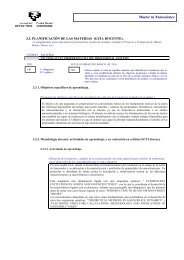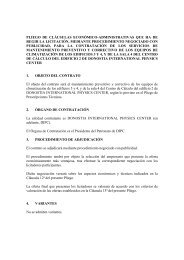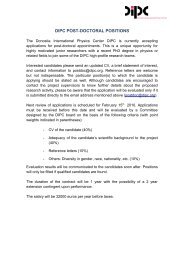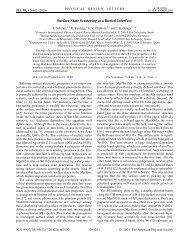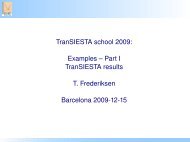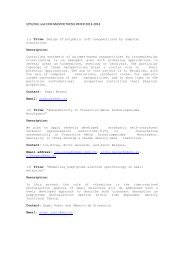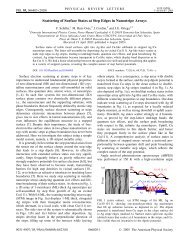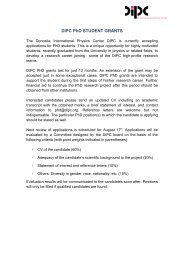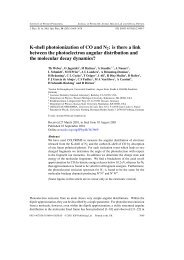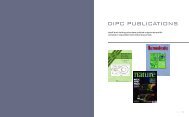Complete report - Donostia International Physics Center - Euskal ...
Complete report - Donostia International Physics Center - Euskal ...
Complete report - Donostia International Physics Center - Euskal ...
Create successful ePaper yourself
Turn your PDF publications into a flip-book with our unique Google optimized e-Paper software.
2011 DIPC Highlight<br />
Quasiparticle interference around<br />
a magnetic impurity on a surface<br />
with strong spin-orbit coupling<br />
A. Strózecka, A. Eiguren, and J.I. Pascual<br />
Physical Review Letters 107, 186805 (2011)<br />
On surfaces with strong spin-orbit coupling, back-scattering is forbidden since it requires flipping<br />
of the spin of the electron. It has been proposed that the forbidden scattering channels in such<br />
systems can be activated if time reversal symmetry is locally broken, for example, by a magnetic<br />
scattering center. Scanning tunneling spectroscopic maps of quasiparticle interference patterns<br />
around a single magnetic MnPc molecule on a Bi(110) surface reveal only spin-conserving scattering<br />
events. In this work we present a real space non-perturbative Green’s functions approach,<br />
confirming that charge-density interference patterns are unaffected by the magnetic state of the<br />
impurity. A fingerprint of backscattering processes appears, however, in the magnetization patterns,<br />
suggesting that only spin-polarized measurements can access this information.<br />
In this work we investigate electron scattering around a single magnetic molecule, a manganese phthalocyanine<br />
(MnPc), on a surface with strong SOC: Bi(110). Bismuth became recently a parent element for various<br />
topological insulators. Strong SOC in Bi surfaces causes large anisotropic spin splitting of its surface<br />
electronic bands and leads to a clear manifestation of spin-dependent scattering phenomena. Figure 1<br />
shows the calculated band structure along high symmetry lines, the spin polarization of the surface states<br />
and the measured density of states.<br />
Figure 2. FFT of charge and spin LDOS modulation<br />
around a magnetic scattering center for<br />
two different spin orientations: out of plane (a)–<br />
(c) and in plane (X2 direction) (d)–(f). The FFT of<br />
charge features similar to the case of nonmagnetic<br />
impurity. A clear fingerprint of scattering<br />
between states of opposite spin is identified in<br />
the magnetization patterns: (b),(e) out of plane<br />
and (c),(f ) in plane.<br />
Figure 1. Electronic and spin structure of<br />
Bi(110) from first principles calculations. (a)<br />
Band structure of the surface electronic states.<br />
SOC splits the surface band into two subbands<br />
(red and blue). (b) dI=dV spectrum of a<br />
clean Bi(110) surface: Peaks F3 and F4 correspond<br />
to the spin-split top of the hole pocket<br />
at and peak F2 to the top of the pocket at M.<br />
(c), (d) Spin texture within the first surface Brillouin<br />
zone, for the lower and upper sub-band,<br />
respectively. The color code represents the<br />
degree of the spin polarization (see the text for<br />
details); arrows show the direction of the spin<br />
in the surface plane. The Fermi contour of the<br />
corresponding sub-band is superimposed on<br />
the plot as solid lines; the dotted lines depict<br />
the contribution from the other sub band.<br />
We make use of a combination of FT-STM experiments with theoretical results considering fully relativistic<br />
non-collinear-spin spinor real space structure + 2x2 Spin Green’s function approach (the first of this type).<br />
We demonstrate in particular that the magnetic moment of the scattering center has a negligible effect<br />
on the LDOS modulation around it. The corresponding QPI maps show no fingerprint of scattering violating<br />
TR symmetry revealing instead a clear dominance of spin-conserving scattering, similar to the case of<br />
nonmagnetic impurities. The simulations allow us to clearly identify the scattering processes suppressed<br />
by the spin polarization of the surface states and determine the interference patterns around a magnetic<br />
scattering potential.<br />
An important results of this work is the prediction that a magnetic impurity with a well defined magnetic<br />
moment induces back-scattering in the system; the effects of it are, however, expected to be observed<br />
only in spin-resolved measurements. Figure 2 illustrates the calculated (the first of this type) reciprocal<br />
space magnetization pattern induced by a localized moment, demonstrating a clear enhancement of several<br />
areas of the Brillouin zone which are clearly suppressed for the case of the total charge modulation.<br />
Spin conservation inducing<br />
a finite magnetization<br />
in a non-manetic material.<br />
66 DIPC 10/11<br />
DIPC 10/11 67



